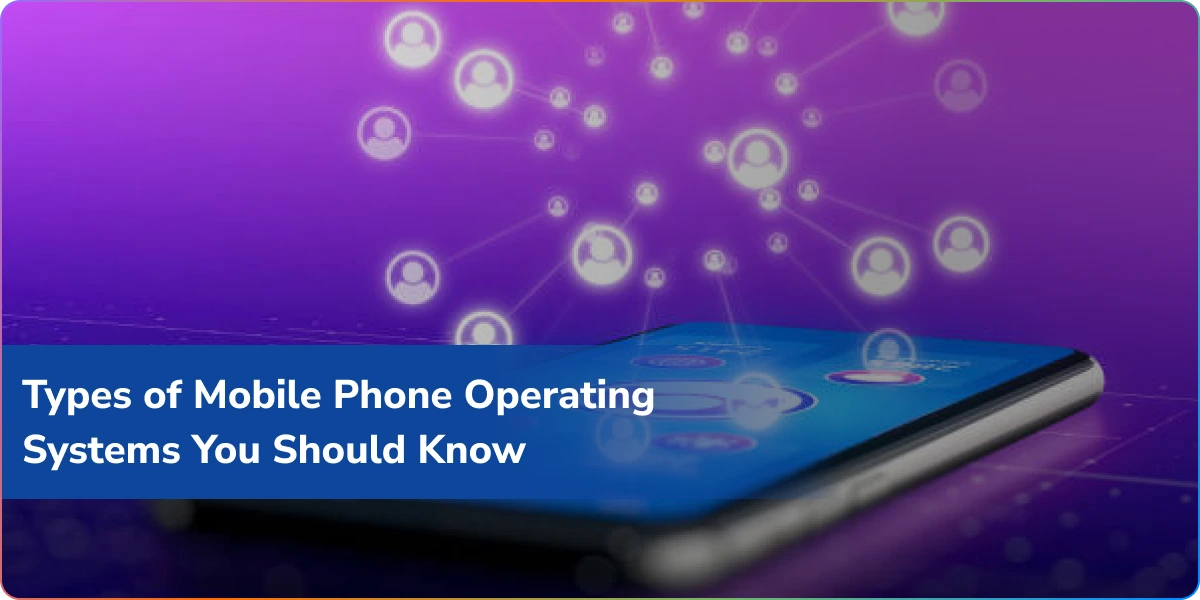Smartphones are an integral part of our lives today that we can’t do without. But have you ever wondered why they work so smoothly? The answer is mobile phone operating systems. Just like computers have Windows, macOS, or Linux, smartphones rely on proprietary phone operating systems that manage everything — applications and memory to calls, camera, and connectivity.
In this blog, we will explore the kind of mobile phone operating systems you should be aware of, how they compare to one another, and examine examples of mobile operating systems that have led to what we understand today. If you’re an enthusiast, app developer, or simply curious about which operating system is ideal for mobile, this is the guide for you.
What Are Mobile Phone Operating Systems?
A mobile OS (mobile operating system) is software that drives your phone’s hardware and software resources. It provides a platform on which apps can function, enables free communication between the user and the device, and controls essential functions like calling, messaging, browsing, security, and so on.
Different mobile OS types have different features, designs, and levels of customization. They may be optimized for security and simplicity, flexibility, gaming, or low cost.
Why You Should Know Phone Operating Systems
It is good to know smartphone operating systems because:
- You may use it to make a decision on which is the best operating system for mobile devices based on your needs.
- Developers need to know different mobile OS types to create programs that can run on any platform.
- Certain types of mobile operating systems provide better security, while others aim at being cost-effective or innovative.
- By knowing the list of mobile OS, you are able to make better buying decisions when you buy a new smartphone.
7 Mobile Phone Operating System Types
Let’s discuss the mobile phone operating system types you should know.
1. Android OS
Android, which is controlled by Google, dominates mobile OS usage worldwide. It powers billions of devices, from low-cost smartphones to high-end flagships.
Key Features:
- Open source and highly customizable.
- Massive app library via the Google Play Store.
- Regular security and performance updates.
- Works with brands like Samsung, OnePlus, Xiaomi, Oppo, and many more.
Why It Matters:
Android is the preferred mobile operating system for many users because it is highly adaptable and is available almost everywhere. It tops the list of the most popular mobile OS because it is well-liked across the globe.
2. iOS (Apple iPhone OS)
Apple’s iOS is arguably the most high-end smartphone operating system. Unlike Android, it’s closed-source and only on iPhones, iPads, and iPods.
Key Features:
- Intuitive and seamless user experience.
- Robust privacy and security protection.
- Access to exclusive and high-quality apps.
- Seamless integration with other Apple devices.
Why It Matters
If you appreciate performance, security, and reliability, iOS is likely to be the best mobile operating system. Its solid ecosystem places it as the second best to Android in terms of global usage.
3. HarmonyOS (Huawei)
HarmonyOS, created by Huawei, was a reaction to Google service bans within China. It’s a cross-platform mobile operating system that is made for smartphones, wearables, tablets, and smart home appliances.
Key Features:
- Multi-smart device compatibility.
- Smooth, responsive performance.
- Supports some Android applications.
Why It Matters:
While quite new, HarmonyOS is an important entry among today’s list of mobile operating systems. It’s popular among Huawei users and could be making its mark big time in the future
4. KaiOS
It is a lightweight mobile operating system for feature phones, otherwise known as “smart feature phones.” It takes the middle ground between low-end phones and modern smartphones.
Key Features:
- Supports apps like WhatsApp, Facebook, and YouTube.
- Runs smoothly on low-hardware devices.
- Features 4G, Wi-Fi, and GPS on affordable phones.
Why It Matters:
KaiOS is the ultimate example of phone operating systems’ capability to empower millions of individuals from developing countries via the offer of low-cost, internet-accessible phones.
5. Windows Phone OS
Despite its lack of availability, Windows Phone OS was a major contender in the space of mobile OS types. It featured a unique tile-based interface and integration with Microsoft services.
Key Features:
- “Live tiles” for a visually unique home screen.
- Close integration with Microsoft Office and OneDrive.
- Smooth operation on compatible hardware.
Why It Matters:
Though no longer in use, it is still one of the most significant mobile operating system examples. It influenced design patterns and remains well-remembered for being innovative.
6. BlackBerry OS
Before Android and iOS, BlackBerry OS was the business worker’s tool of choice. It was renowned for its physical QWERTY keyboards and extreme security and had a devoted fan base.
Key Features:
- Enterprise-level security.
- Advanced email and messaging services.
- Built with physical keyboards in mind.
Why It Matters:
Although BlackBerry OS is no longer present, it remains in the list of mobile OS because it was a key driving force that has shaped mobile communication.
7. Symbian OS
Symbian was the predominant phone operating system, especially in Nokia’s prime. It powered millions of phones during the early 2000s.
Key Features:
- Lightweight and efficient for early mobile hardware.
- Handled multitasking even when it was still catching up.
- Had a strong developer base at its peak.
Why It Matters:
Though old today, Symbian is an old-timer in the background of smartphone operating systems. It set the stage for Android and iOS to lead the way.
The 5 Most Commonly Used Mobile Operating Systems Today
While there are many types of mobile phone operating systems, few are being used today. The 5 mobile operating system options that are most dominant in the market today are:
- Android OS
- iOS (Apple iPhone OS)
- HarmonyOS (Huawei)
4.KaiOS
5.(Historically) Windows Phone OS
These systems make up the master list of mobile OS available for use by users, developers, and organizations.
Comparing the Types of Mobile Phone Operating Systems
Here’s a quick comparison table of popular mobile OS types:
| Mobile OS | Developer | Strengths | Status |
| Android | Customization, huge app ecosystem | Active & leading | |
| iOS | Apple | Security, smooth performance | Active |
| HarmonyOS | Huawei | Cross-device integration | Active, growing |
| KaiOS | KaiOS Tech | Affordable, lightweight, basic app support | Active |
| Windows Phone OS | Microsoft | Microsoft ecosystem, unique interface | Discontinued |
| BlackBerry OS | BlackBerry | Security, enterprise use | Discontinued |
| Symbian OS | Nokia | Lightweight pioneer OS | Discontinued |
What Is the Best Operating System For Mobile Phones?
The best mobile operating system is the one that suits your needs:
- Best overall: Android (for best choice and flexibility) and iOS (for best premium feel and security).
- Best budget option: KaiOS, which brings the internet at a low price.
- Best new contender with a fresh approach: HarmonyOS, with its cross-device ecosystem.
- Historically important: Symbian, BlackBerry, and Windows Phone are pivotal mobile operating system examples, even though they are inactive.
Conclusion
The world of smartphone operating systems has come a long way from Symbian and BlackBerry to Android and iOS today. While HarmonyOS and KaiOS add variety to the mix, the choice of OS decides how we use and interact with smartphones.
At Logixbuilt Solutions, we create high-performing mobile applications for each major mobile OS category. Android, iOS, or cross-platform, our experienced experts have your app run fast, securely, and conveniently.
Get in touch with Logixbuilt Solutions now and make your mobile app idea a reality!
FAQ’s
Q1: What are 5 mobile operating system examples?
Ans: Android, iOS, HarmonyOS, KaiOS, and Windows Mobile (legacy). They are the most prevalent and influential categories of mobile OS in recent times.
Q2: What is the best operating system for mobile phones?
Ans: The optimal mobile operating system is up to your requirements. Android excels in variety and customization, iOS excels in performance and security, HarmonyOS is expanding in innovation, and KaiOS excels in budget internet-capable devices.
Q3: What are the primary types of modern mobile phone operating systems?
Ans: Android and iOS are the popular mobile phone operating system varieties, and HarmonyOS and KaiOS are interesting alternatives. Symbian, BlackBerry, and Windows Mobile systems characterized the smartphone’s early days.
Q4: Does KaiOS qualify as a smartphone operating system?
Ans: Yes. Although it’s designed for feature phones, KaiOS supports apps like WhatsApp, YouTube, and Facebook, so it’s a lean but usable smartphone operating system for budget phones.
Q5: Why should you know about different kinds of mobile OS?
Ans: So that you can choose the right phone by understanding phone operating systems. Each mobile OS offers its own set of advantages, whether it is Android’s personalization, iOS’s security, or KaiOS’s affordability.


